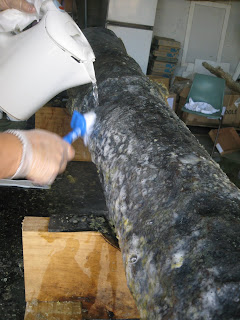 |
| Final removal of Kwik Strip from the touch hole |
Over the last few weeks we’ve been following the story of our Bounty Cannon Conservation Project, funded by the National Library of Australia through the Community Heritage Grants Program. The first step was the making of the replica cannon and now that that is complete we have begun the conservation work. Janelle Blucher has been heading this work with phone advice from Karina Acton from International Conservation Services.
Janelle has been assisted by our wonderful volunteer Sue Brian who has been there each day to help with the work. The first step they had to undertake was the removal of the surface coatings. Until they began applying the Kwik Strip, which is then brushed and washed off, it was not clear how much time this would take but we had set aside a week to do the job. However progress was so good that they had removed all the coatings by Wednesday afternoon. And when the coating was removed we discovered that the surface corrosion activity was not as bad as we had thought it could be. The top side of the cannon has more corrosion than the bottom side, which you would expect as it is more exposed. The heavier areas of corrosion are being treated with citric acid thiourea poultices, before a rust converter is applied and finally the whole cannon will be sealed with Senson Ferroguard to protect it against future corrosion.

The bore of the gun was trickier to assess. We knew that this was the area with the most corrosion and was going to be the most difficult to work with. As the bore goes right up to the touch-hole region which is 1.5 metres long, it presents us firstly with the difficultly of being able to see all the way up, and secondly with how to get to the top area to clear the corrosion. Using a long arm torch Janelle and Sue were able to see up to the top area and asses the corrosion. Once again we were very pleased to discover that it appears the corrosion does not go deep into the cannon.
 |
| Tlting the cannon to get to corrosion in the bore |
With the help of Lee Irvine the cannon was tilted so that the iron corrosion could be removed with a wire brush mounted onto a 2 metre extension arm and also an air gun on an extension. A few objects that we weren’t expecting to see came out of the bore during the brushing – a beer top, an Anticol wrapper, a piece of paper and a nail - not quite from 1790! A series of sprayings with rust converter and dewatering then occurred.
Finally, Senson Vapour Guard Pads will be inserted, which are corrosion inhibitors, together with silica gel and then a tampion will be inserted into the end to seal the bore. All these treatments have been recommended by the Western Australian Maritime Museum and Karina Acton.
 |
| Wire brushing |
Kel Adams came into the Museum with an article from Pix Magazine, August 19, 1950 (reproduced here). It has a photo of the cannon in the New Military Barracks compound being inspected by Johnnie Young, Pastor Pat Adams, Ben Christain and Carty Christian. A fabulous image and amazing to see the cannon where it stood for so many years before being restored in Western Australia – many thanks Kel for bringing it in. If anyone has any other images of the cannon, particularly when it was used in the Compound on Bounty Days, I would really appreciate being able to see them. Please give me a call on 23788.
 |
| Using the air gun to remove debris |
 |
| Unexpected finds from the bore of the cannon! |
It has been fascinating to watch the progress of this Project. One of the most inspiring aspects has been that the solutions to all of problems posed with handling the cannon have been resolved by our local people. We should not underestimate the skill of our local Administration and Museum workers – it is solid indeed.
 |
| From PIX Magazine, 19 August 1950 |






















































